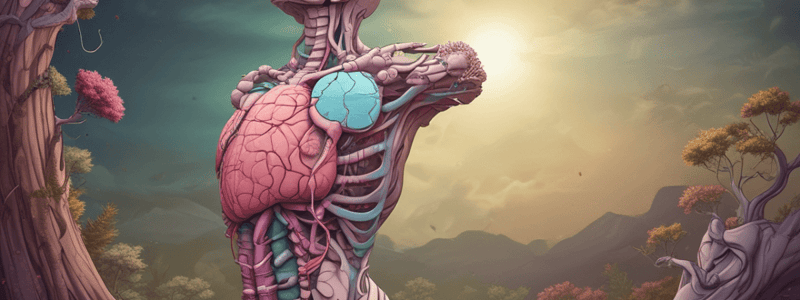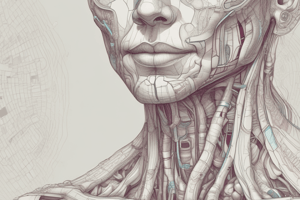Podcast
Questions and Answers
What is the primary function of the thyroid gland?
What is the primary function of the thyroid gland?
- Synthesis of thyroid hormones (correct)
- Inflammation of the thyroid gland
- Regulation of water and electrolyte balance
- Production of serotonin and other amine derivatives
What is the most common cause of hyperthyroidism?
What is the most common cause of hyperthyroidism?
- Thyroiditis
- Graves' disease (correct)
- Endemic goiter
- Cushing's syndrome
What is the primary function of the parathyroid glands?
What is the primary function of the parathyroid glands?
- Production of serotonin and other amine derivatives
- Regulation of water and electrolyte balance
- Synthesis of thyroid hormones
- Not mentioned in the content (correct)
What is the term for the process by which cells take up and decarboxylate amine precursors?
What is the term for the process by which cells take up and decarboxylate amine precursors?
What is the term for the enlargement of the thyroid gland due to iodine deficiency?
What is the term for the enlargement of the thyroid gland due to iodine deficiency?
What is the approximate weight of the adrenal gland?
What is the approximate weight of the adrenal gland?
What is the term for the inflammation of the thyroid gland?
What is the term for the inflammation of the thyroid gland?
What is the term for cells that produce serotonin and other amine derivatives?
What is the term for cells that produce serotonin and other amine derivatives?
What is the condition characterized by a deficiency of cortisol and aldosterone?
What is the condition characterized by a deficiency of cortisol and aldosterone?
What is the term for the outer layer of the adrenal gland?
What is the term for the outer layer of the adrenal gland?
What is the function of the endocrine system?
What is the function of the endocrine system?
What is the term for a chemical messenger that targets a specific group of cells?
What is the term for a chemical messenger that targets a specific group of cells?
What is the term for a cell that produces a hormone that stimulates or inhibits its neighbor?
What is the term for a cell that produces a hormone that stimulates or inhibits its neighbor?
What is the location of the pituitary gland?
What is the location of the pituitary gland?
What is the term for the component of the pituitary gland that produces hormones that regulate growth and development?
What is the term for the component of the pituitary gland that produces hormones that regulate growth and development?
What is the term for the cells that produce growth hormone in the pituitary gland?
What is the term for the cells that produce growth hormone in the pituitary gland?
What is the result of oversecretion of growth hormone in childhood?
What is the result of oversecretion of growth hormone in childhood?
What is the term for the condition that results from oversecretion of growth hormone in adulthood?
What is the term for the condition that results from oversecretion of growth hormone in adulthood?
What is the term for the part of the pituitary gland that consists of cysts filled with colloid?
What is the term for the part of the pituitary gland that consists of cysts filled with colloid?
What is the weight of the hypothalamus?
What is the weight of the hypothalamus?
What is the primary function of the hypothalamus?
What is the primary function of the hypothalamus?
Which of the following is NOT a function of the hypothalamus?
Which of the following is NOT a function of the hypothalamus?
What is the role of the pars nervosa?
What is the role of the pars nervosa?
What are Herring bodies?
What are Herring bodies?
What is the function of pituicytes?
What is the function of pituicytes?
What is the function of the pineal gland?
What is the function of the pineal gland?
What is the approximate weight of the thyroid gland?
What is the approximate weight of the thyroid gland?
What is the location of the hypothalamus in the brain?
What is the location of the hypothalamus in the brain?
What is the primary role of the hypothalamus in hormone production?
What is the primary role of the hypothalamus in hormone production?
What is the function of corpus arenaceum?
What is the function of corpus arenaceum?
Flashcards are hidden until you start studying
Study Notes
Thyroid Gland
- Built with two lobes connected by a necking
- Composed of follicles, colloid, blood vessels, and parafollicular cells (C cells)
- Function: Synthesis of thyroid hormones (T4 and T3)
- T3: triiodothyronine
- T4: thyroxine
Thyroid Hormones
- Produced by principal cells (clear cells)
- Regulated by parafollicular cells (C cells)
Thyroid Disorders
- Graves' disease: autoimmune disease, 80-90% of all hyperthyroidism, mostly affects women
- Thyroiditis: inflammation of the thyroid, mostly chronic-autoimmune, presents as goiter
- Endemic goiter: enlargement of the thyroid gland due to iodine deficiency in the diet
Parathyroid Gland
- Composed of oxyphil cells and principal (chief) cells
- Function: regulates water and electrolyte balance
Adrenal Gland
- Weight: approximately 18g (adrenal cortex) and 4g (adrenal medulla)
- Composed of adrenal cortex (95% of the gland) and adrenal medulla (5%)
- Adrenal cortex: divided into three zones - zona glomerulosa, zona fasciculata, and zona reticularis
- Function: regulates water and electrolyte balance
Endocrine System
- Includes endocrine glands and their hormones
- Function: secretes hormones into the bloodstream to regulate various bodily functions
- Hormones: chemical messengers that target specific groups of cells to stimulate or inhibit activity
Endocrine Glands
- Locations: pituitary gland, thyroid gland, parathyroid gland, adrenal gland, pineal gland, and others
- Hormones: proteins, glycoproteins, small peptides, amino-acid derivatives, and steroids
Communication Pathways
- Autocrine: cell produces hormone that stimulates or inhibits itself
- Paracrine: cell produces hormone that stimulates or inhibits its neighbor
- Juxtacrine: cells sit side by side, one has hormone on its surface, the other has the receptor
Pituitary Gland
- Weight: approximately 0.5-1g
- Diameter: approximately 1 cm
- Components: adenohypophysis (anterior lobe) and neurohypophysis (posterior lobe)
Pituitary Gland Cells
- Chromophils: acidophils and basophils
- Chromophobes: non-staining cells
- Adenohypophysis: produces hormones that regulate various bodily functions
- Neurohypophysis: stores and releases hormones produced by the hypothalamus
Pituitary Hormones
- Growth hormone (GH): regulates growth and development
- Oversecretion: gigantism in childhood and acromegaly in adulthood
- Undersecretion: dwarfism in childhood
Hypothalamus
- Weight: approximately 0.7g
- Diameter: approximately 1 cm
- Location: center of the brain, between the pituitary gland and thalamus
- Function: regulates hormone production, body temperature, thirst, appetite, emotions, sleep cycles, sex drive, and other bodily functions
- Acts as the connector between the endocrine and nervous systems
Pineal Gland
- Weight: approximately 0.2g
- Length: 5-8 mm
- Width: 3-5 mm
- Composed of pinealocytes, interstitial glial cells, and corpus arenaceum (brain sand)
- Function: regulates sleep-wake cycles and reproductive hormones
Studying That Suits You
Use AI to generate personalized quizzes and flashcards to suit your learning preferences.





